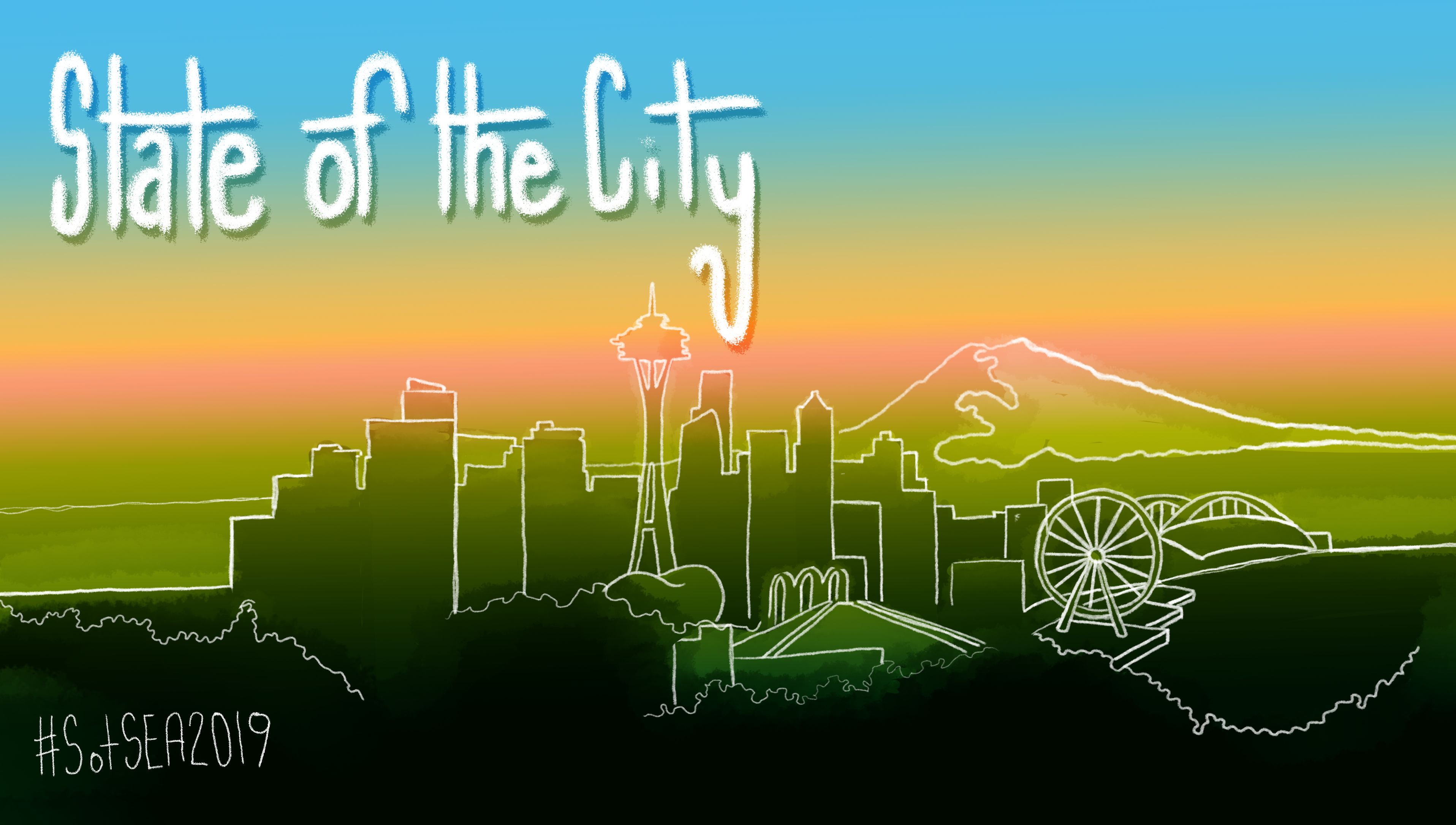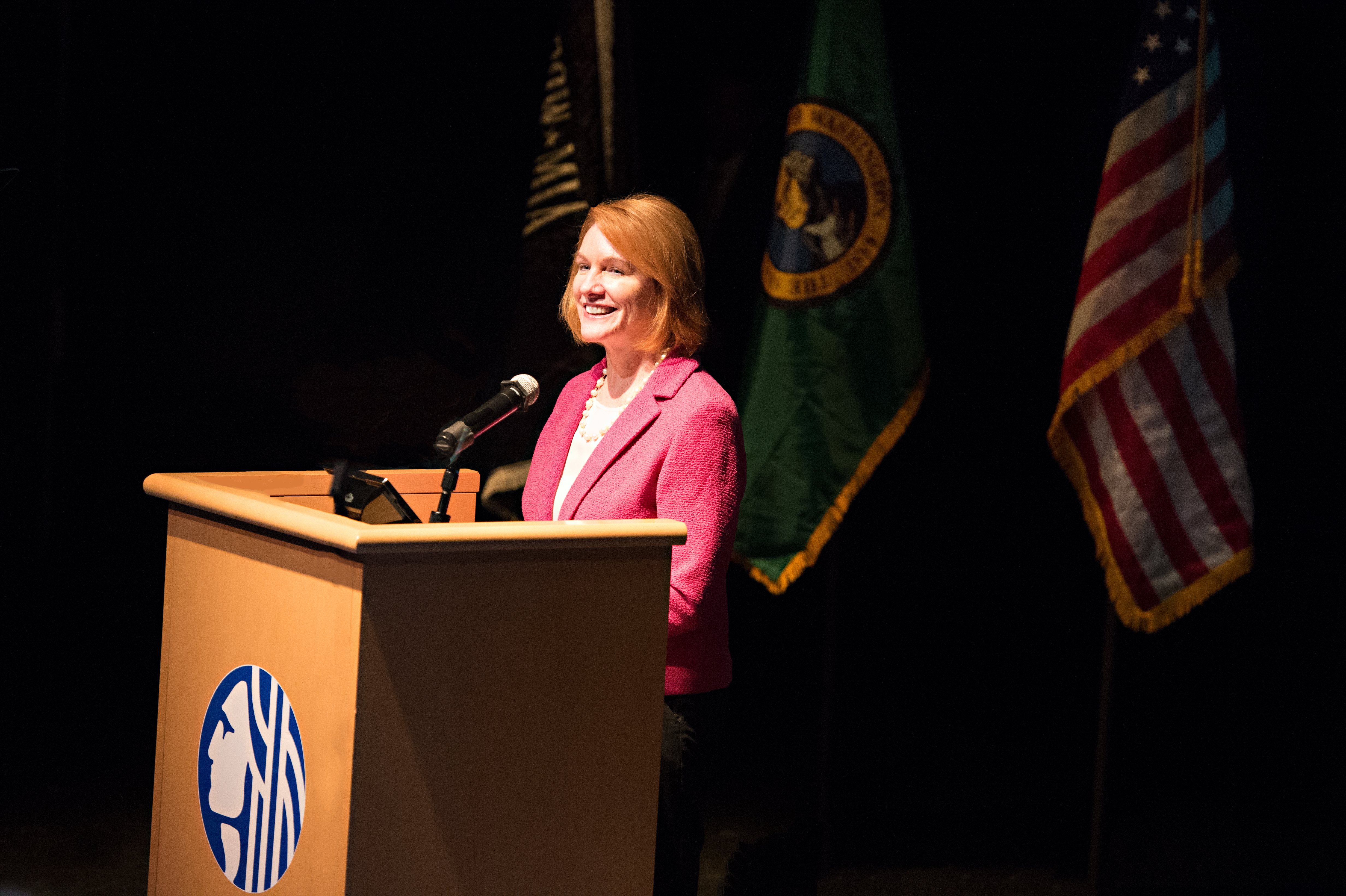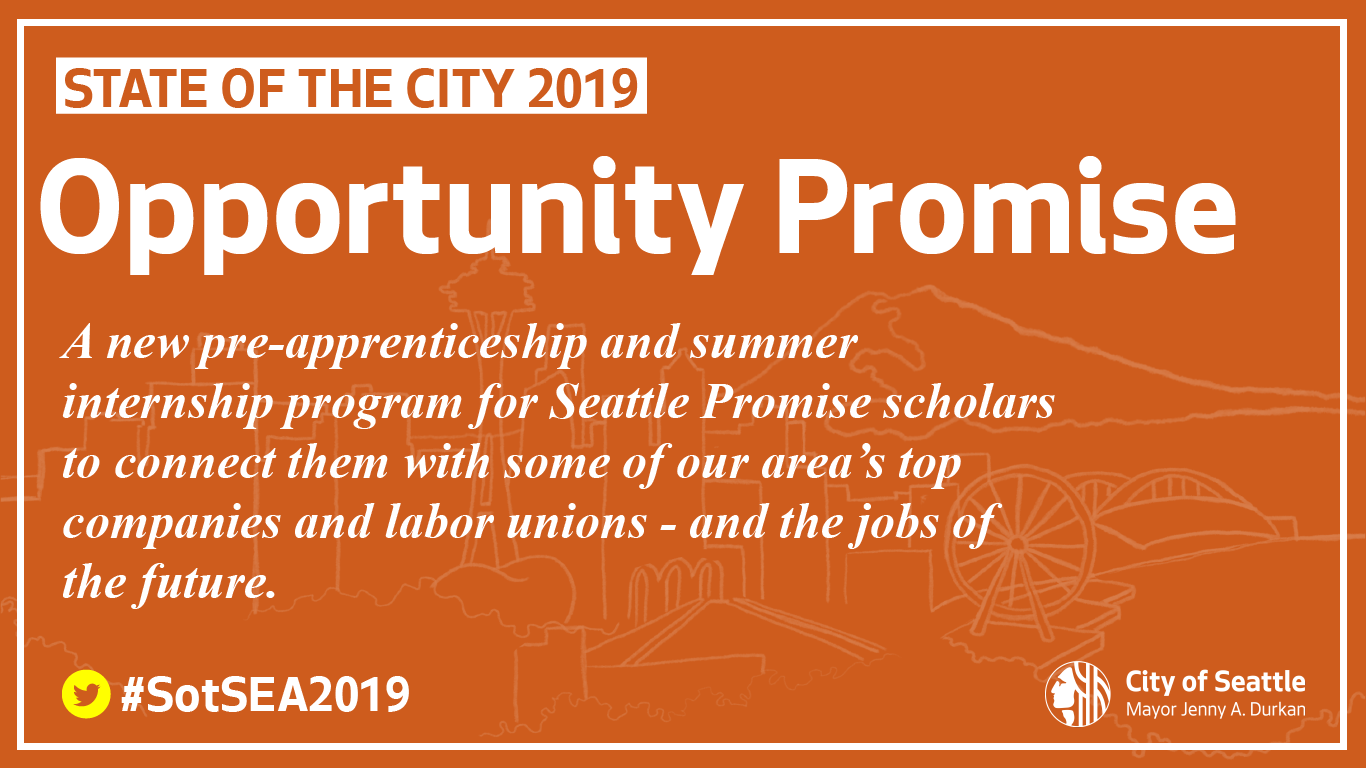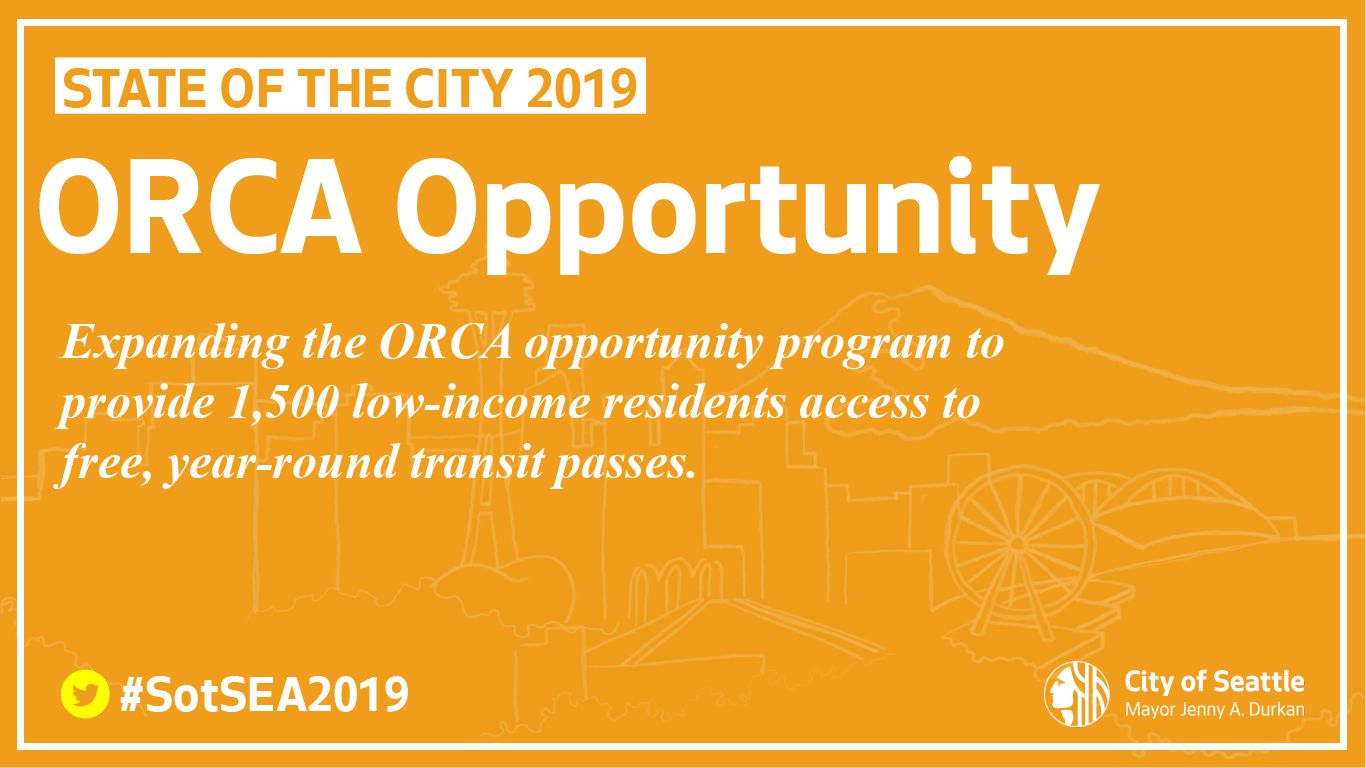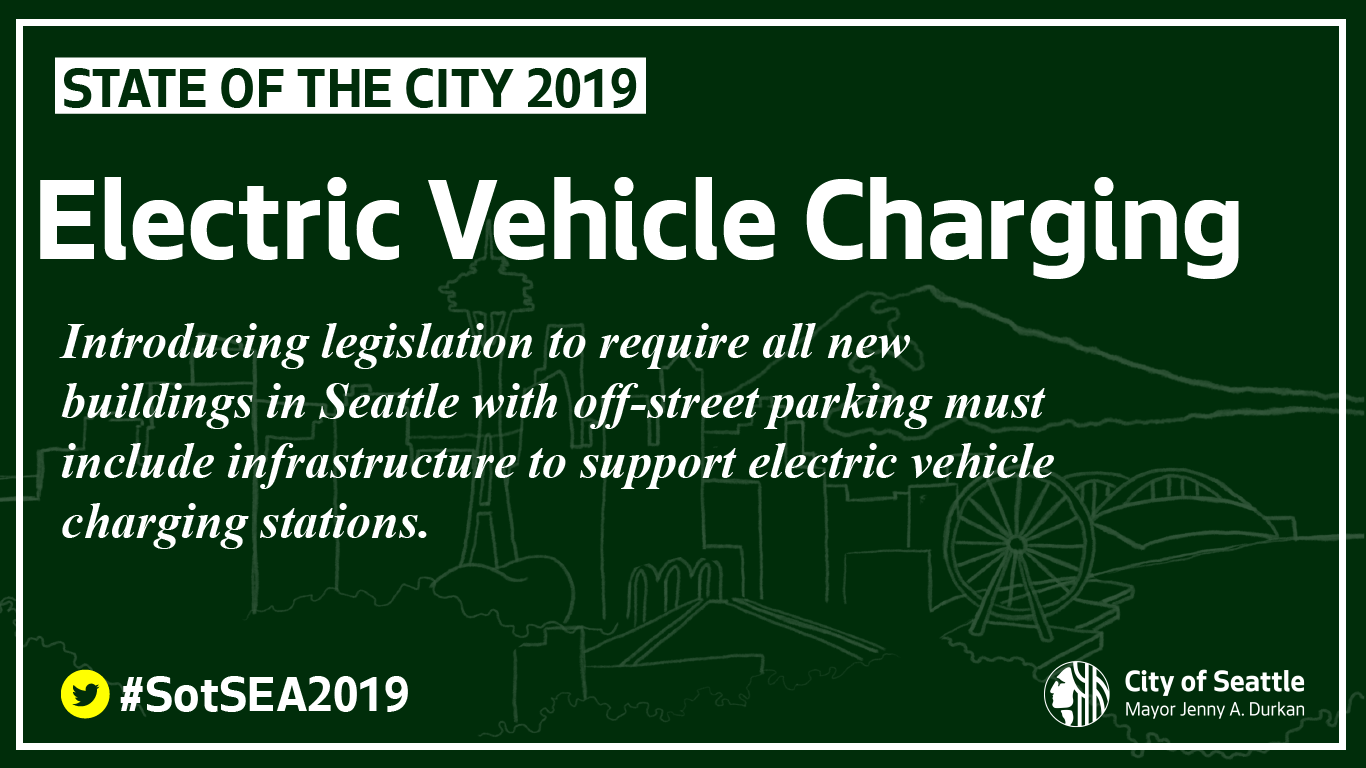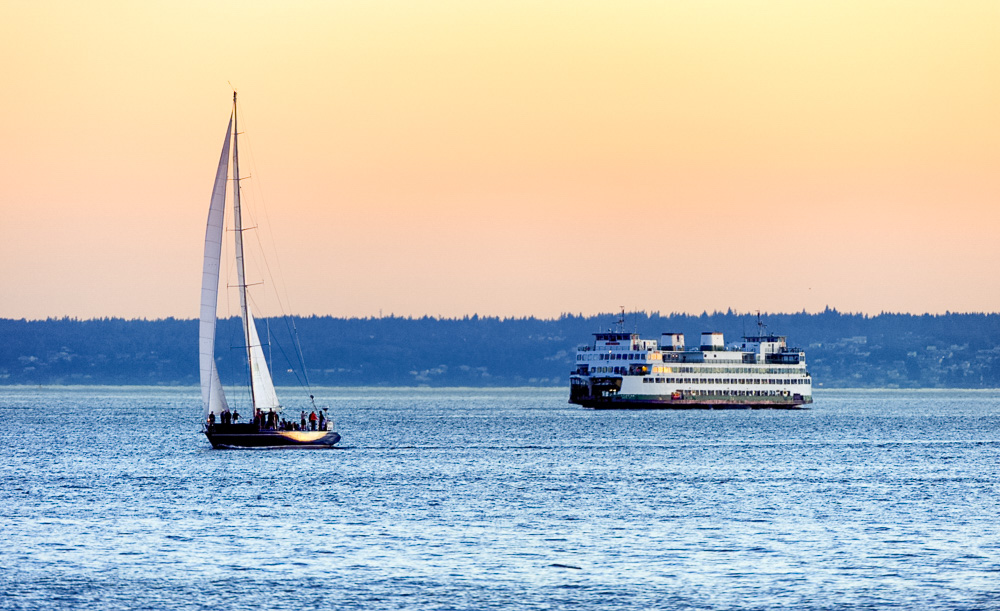
At a time that Seattle is literally under construction, Mayor Jenny Durkan laid out her vision to build a an affordable, inclusive City of the future. Speaking to students and community members at North Seattle College, Mayor Durkan affirmed her commitment to addressing Seattle’s housing and homelessness crisis, building economic opportunity by connecting young people with jobs and training, create a safer, more just and equitable city, and building new civic treasures connected by a world-class transit system.
Watch the Speech
Building a City of the Future
To help achieve that vision, Mayor Durkan:
- Will expand the ORCA Opportunity program by partnering with the Seattle Housing Authority to provide 1,500 low-income residents access to free, year-round transit passes;
- Announced a new Executive Order that she will sign later this week to bring together the City’s work to prevent displacement and gentrification;
- Partner with business and labor leaders to create the new “Opportunity Promise” program to connect Seattle Promise students with internships.
- Unveiled her plan to require all new buildings in Seattle to provide charging infrastructure for electric vehicles; and
- Created a new Seattle Promise Equity Scholarship, which will provide Seattle Promise students already receiving tuition-free college resources for non-tuition expenses, like food, housing, and child care.
As she laid out a vision for Seattle, Mayor Durkan also highlighted urgent action since the she took office to deliver on key priorities:
- Delivering on the basics and essential city services that residents expect, especially during the permanent viaduct closure and back to back snow storms;
- Investing over $710 million with partners to build more affordable housing;
- Expanding bridge housing and emergency shelter by 25 percent, the largest single increase in Seattle’s history;
- Creating the Seattle Promise College Tuition Program to provide Seattle public high school students two years of free college;
- Delivering ORCA Opportunity, which has provided more than 14,000 Seattle students access to a free-year round ORCA transit pass; and,
- Standing up to the NRA and enacting a new gun safety law;
- Securing a fair new contract for Seattle Police Department officers that advances public safety and reform;
- Vacating misdemeanor marijuana possession convictions and non-violent, low-level offenses;
- Enacting a Domestic Workers Bill of Rights;
- Protecting Seattle’s refugee and immigrant neighbors; and,
- Expanding bus service by 30%, creating a permanent bike share program, and moving ahead on the Center City Connector streetcar.
Full Transcript: 2019 State of the City
As delivered on February 19, 2019 at North Seattle College
Thank you so much.
Council President Harrell, members of the City Council…
Cabinet members, fellow elected officials, veterans, community leaders, members of the clergy, my family and friends….
And also a special thank you to the North Seattle College students and staff….
Good afternoon!
I am honored to be with you for my second State of the City address.
And I am so happy to be here at North Seattle College.
This is a really exciting time for this College and the entire Northgate community:
At this incredible institution, access to education is empowering Seattleites of every age and every background.
Here we are creating a bridge to opportunity – and soon a new pedestrian bridge will connect you with even more.
The new home of hockey in Seattle. The Kraken! There is no such thing as a fierce fish.
A new Link Light Rail station.
More affordable housing.
Northgate reflects and is its own epicenter of a better future for our city and our entire region.
So I want to thank Chancellor Pan, President Brown, the entire staff, and the students for hosting us here today.
Councilmember Juarez, I also want to thank you for that introduction, and for having us here in your beloved District 5.
You know, I was tempted to call this “Live in D5!”
But I heard you have the copyright.
I also would like to pause and acknowledge the councilmembers who are not seeking re-election, including Councilmembers Harrell, Bagshaw, O’Brien and Johnson.
I want to thank you for your work to make Seattle a better, more just city.
I’m here today because getting out of City Hall is the only way to do this job.
I have learned so much from the hundreds of meetings in communities this last year.
From roundtables with young people in South Park, Rainier Beach, and Lake City….
To community meetings in Capitol Hill, Ballard, and the Central District….
Or just touring small businesses in Hillman City, Georgetown, and West Seattle.
And those are just the “official meetings.”
I often get a pop-up, “Talk to the Mayor” event wherever I go.
Even on date nights.
Sorry, Dana.
But really: I have loved meeting Seattleites of every age and background in every corner of this city.
Like the little girls whose eyes lit up when their parents and I explained to them that, yes, I’m the mayor…
…and that yes, here in Seattle, girls can be mayors, too.
Sometimes it amazes even the little boys.
Like one little boy I met whose face turned very serious when his parents told him who I was.
Then he asked:
“Can boys be mayors, too?”
And I said of course.
In Seattle, anyone should have the chance to be mayor.
Anyone.
Another thing I know for sure is we have great people here in Seattle.
Everywhere I go people ask how they can help, what they can do to make their community better.
In the last six weeks, we’ve seen and lived that.
We faced the longest major highway closure in our region that we have ever seen.
We asked people to step up.
And people responded.
They got out of their cars and onto transit.
Bikes.
Walking.
Water taxis.
Light rail.
They worked from home.
For three weeks.
And it made a huge difference.
Then, we faced the snowiest month in Seattle in over fifty years.
So we stuck together.
We checked on our neighbors.
We shoveled our neighbor’s sidewalks.
Then we went to the local schools and shoveled them out, too.
Together with our partners in the community and at the County, we stood up emergency shelters and brought many hundreds of people living outside and unsheltered inside where its welcoming and warm.
Across the City, so many individuals worked long hours to create not just shelters – but warm, safe, and affirming places.
Thank you to all the workers and volunteers at our shelters.
People like Laurie Reddy, who I was lucky to meet at the emergency shelter at Bitter Lake Community Center.
Laurie is a first-grade teacher, god bless her, at the Broadview Thompson.
When school was canceled, Laurie headed to help at the emergency shelter at Bitter Lake.
She cooked meals.
Organized donations.
Helped the families.
Basically did whatever was needed.
And our city employees and first responders worked around the clock.
Take Pat Urlacher, from the Seattle Department of Transportation.
Pat is one of our heavy truck drivers, and he and his team worked from noon to midnight every day of the storms plowing our roads.
When there were breaks in the storms, he found other ways to help:
Lance Myers and Ray Bernardez work at the Seattle Parks & Recreation.
During the storms, Lance and Ray jumped in to drive a plow on Beacon Hill.
Lance worked the overnight shift, Ray jumped in in the morning.
All to make sure Beacon Avenue was clear, so that people could get to the VA Hospital and the Jefferson Community Center.
I also want to recognize the efforts of our Navigation Team, who literally saved lives over the last two weeks.
Jackie St. Louis and Christina Korpi are two of our Navigation Team leaders who work closely with Seattle Police Officers Eric Zerr, Kyle Knox, and Jimmy Stewart.
Our Navigation Team did double duty during the storms.
During the day, they helped get emergency shelters up and running, so more people could move into safer places.
At night, they went outside in the freezing weather, snow and ice.
They reached out to people to help them get inside, and they helped transported people to shelter.
Each of them worked around the clock.
Sometimes sleeping on the floor of their offices for a few hours – and then they were back at it again until the next day.
Our Navigation Team did wellness checks and offered blankets and coats to 700 people and brought nearly 200 people inside so they could get access to services and a warm place to sleep.
Many of the members of the Navigation Team are here today, as are the other city workers.
I hope you can please stand – and we can thank them and our first responders for their heroic work over the last few weeks.
But all year round, our City employees show up to work and ask how they can make Seattle a better place to live, work, and visit.
They help us get government right.
So to all City employees, and to my Cabinet, particularly those who shared shovel – thank you.
I know we expect a lot of you.
And you have worked hard not just over the last six weeks, but all year
I know you’ll continue to deliver for the people of Seattle, to help get government right, and deliver on those basic city services that everybody needs.
Now, I know this last six weeks hasn’t all been easy.
It was particularly hard on our differently abled neighbors and our seniors — who already face daily challenges with mobility.
For too many in Seattle, getting around on our sidewalks and at bus stops was just too hard.
Many of our small businesses faced a tough time.
We are already working to see how our City can all do better on every front.
So from the Seattle Squeeze to the Big Freeze — it was challenging.
But Seattle rose to the occasion.
So let’s not make that a “moment.”
Let’s keep doing those things that made us better.
So I can say the State of our City is strong and resilient.
Yes, we have great challenges ahead, but we have even greater people.
And because of our people, Seattle has always been on the leading edge of innovation.
A place where people imagined a better way, and then invented it – and then made it a reality in people’s lives.
The 15 dollar minimum wage.
Airplanes and online travel.
Stem cell transplants and strategies to end global diseases.
Personal computers and the ability to order almost anything on them.
So much more.
We have always invented the future.
And that’s what I want to discuss today: How together we can build a city of the future.
We have a generational opportunity to intentionally choose what kind of city we want to be 50 years from now.
Because today, Seattle is at a turning point.
We are quite literally under construction.
And now is that moment in time that we can build the city we want.
We must remember that real progress advances our common humanity.
And our social compact is strongest when built upon our mutual dreams and aspirations — when we all strive towards a shared vision of what is possible.
And from listening to Seattle, I believe we have that shared vision.
We have a vision for a city that is diverse, and continues to beckon and welcome newcomers.
But that also protects against gentrification and displacement, and makes it possible for families to stay in Seattle.
A city that builds an economy that actually benefits the workers and provides the protections, wages, benefits and housing they deserve.
A city where we build true economic opportunity.
A city where your zip code or the color of your skin does not set your destiny.
Where we act boldly and creatively to prevent homelessness – and to house and support the people experiencing it.
Where policies are built on the truth that public safety cannot exist without equity and justice.
A city that is connected – from walking to biking to bus service to – yes – light rail with great public spaces, marvelous parks and lots and lots of green.
Today we can celebrate that we took some big steps last year towards a more just and equitable future:
Like $710 million committed to affordable housing.
The largest shelter increase in our City’s history.
Free college for our young people.
Free transit passes for 14,000 students.
A Domestic Workers Bill of Rights.
Together, despite the challenges we fact, we can continue to make big steps and chart a path together toward realizing that city of the future we all want.
Let’s talk first about how a city of the future acts to address an affordable housing and the homelessness crisis.
Let’s call it what it is:
A moral challenge.
In the last year, we continued our urgent action to take on this challenge.
Since I took office, we have invested over $710 million together with our partners in affordable housing.
Over $710 million.
We added 360 permanent new affordable homes and are on track to add 3,600 more by 2022.
The City is doing more than ever to help our neighbors who are living unsheltered, and we’ve created greater accountability, helped more people and ensured we do the most good with our resources.
In 2018 alone, the City served more than 25,000 households experiencing homelessness.
In 2018, we helped more than 7,400 households move out of homelessness and into permanent housing – a 30 percent increase over 2017.
And we’ve made investments in our 24/7 shelters that are moving more people out of homelessness than basic shelters ever have.
We delivered on an historic 25 percent expansion of our City’s shelter space – opening more than 500 new safe places in Seattle.
And we know those safer places we have helped create and are changing lives.
I want to tell you a story about one of those places.
Bailey Boushay House opened in 1992.
At a time of great despair, it was a ray of hope.
The AIDS epidemic was in full force, and most of those AIDS patients were gay men.
Bailey Boushay grew out of this human crisis and provided an oasis of caring.
In the crisis of homelessness we face today, it’s done so again.
About one third of the people in Bailey Boushay’s HIV outpatient program during the day are homeless, but after 4 pm, they would have to find somewhere else to stay for the night – many times in nearby parking garages or doorways.
Then one of Bailey Boushay’s own clients and their Executive Director had an idea:
Could Bailey Boushay be a safe place 24 hours a day?
So in November, as part of our work to create those 500 new safer places, the City helped Boushay House open a 50-bed shelter for our neighbors living with HIV.
The first of its kind in the country.
Having that more stable, safer place is helping people transition out of homelessness and into housing.
That’s the kind of city we can be.
Stories like that show what we can do when we deal with each other with our common humanity.
That’s when we show what’s best about Seattle.
While continuing our urgent action to the crisis on our streets, we also took steps toward addressing the fractured, siloed approach to homelessness in our region that has persisted for far, far, far too long.
After years of talk, we finally took steps toward what our region needs:
One unified system that has the governance, authority, and resources to prevent homelessness, and to deliver for people experiencing homelessness.
Our system has been too fractured for far too long.
I know we have a lot more to do as we unify our work.
But we have laid the foundation for a new approach that will better serve the people we all want to help.
Imagine: authority, responsibility and resources under one roof, rowing in the same direction and actually centering their work on the lives and voices of those being served.
But unified services, and better behavioral health options are just part of the solution.
We need more affordable housing.
We need more housing for our low-income neighbors or people experiencing homelessness.
We also need affordable housing for middle-income Seattleites who have raised their kids here, but now see a city where those kids can’t afford to live.
We want people who work in Seattle to be able to afford to live in Seattle.
This year, our City will rethink and double down on our efforts to create more affordable housing for all families in Seattle.
We will pass the Mandatory Housing Affordability and continue to improve it to ensure that our fastest-growing neighborhoods can be vibrant, livable places for the next generation.
We will continue to be creative and leverage our tens of millions of dollars in new affordable housing investments, including by moving forward on redeveloping Fort Lawton to create housing opportunities for low income seniors, veterans and families.
We will streamline and re-examine our entire City’s real estate portfolio for affordable housing opportunities.
Working with nonprofits, businesses, community leaders, and philanthropy, we will push to create more housing for middle-income Seattle.
Because too many of our workers – including our city employees, our nurses, our teachers, firefighters, and police officers – are getting priced out of this great city, and we have to stop that.
We will do more to address displacement and gentrification.
As our city has grown we have seen far too many communities of color have been pushed out of their homes in Rainier Beach, the Central District, Beacon Hill and Chinatown-International District.
It’s why we are expanding our work with communities to address this through unprecedented investments in community-based projects like Africatown, the Filipino Community Center, the Ethiopian Community Center, United Indians of All Tribes, and Duwamish Valley Affordable Housing Coalition.
You can clap for those people they work hard.
And other families, particularly retirees, are finding it impossible to maintain their home in any part of our city.
This week, I will sign an Executive Order to refocus our work on strategies to prevent displacement and gentrification.
Because as we create new opportunities in every part of this city, we must ensure a mix of housing units from deeply affordable to market rate while creating more affordable spaces for small businesses, community organizations or artists.
Everyone has to be welcome in every part of our city.
We will continue to act with a sense of urgency to meet this moral challenge.
Our city of the future must also be one where people have access to opportunity and jobs.
We should all be proud of what we’ve done over the last year together to make those connections possible.
On my first day in office in 2017, we created the Seattle Promise College Tuition Program to expand the one-year South Seattle pilot program to two free years at to all Seattle colleges.
When I took office, there were 135 students that were enrolled at South Seattle College.
For the next school year, we now have more than 520 students who have applied to be part of the Seattle Promise.
And thanks to Seattle voters, every Seattle public high school student has the promise of two years free college.
We have a number of those Seattle Promise students in the house today let’s give them a round of applause.
I just love thinking about the impact these students are going to have on the Seattle of the future.
The next great innovator on climate change, curing diseases or empowering community could be sitting in one of our Promise classrooms.
And for any student watching, you have until Friday to apply for Seattle Promise!
In March, I will be sending our plan to execute on the Families, Education, Preschool and Promise levy to fully realize that expansion, high quality preschool to 1,700 kids, close the opportunity gap for our K-12 students, and helping those elementary school teachers, thank you Seattle!
On Thursday, in partnership with Seattle Colleges, we will also announce the availability of a new Seattle Promise Equity Scholarship.
Because tuition is not the only barrier to college, this program allows many income-eligible 13th year and 14th year Promise Scholars in our Seattle Colleges to receive resources for things like books, child care, and food.
So with Seattle Promise, we are building bridges to college.
We need to build bridges to jobs, too.
This spring, we will launch a new program that will give Seattle Promise students the chance for pre-apprenticeship programs with our trades and summer internship training with top area companies and trade groups.
Together as a City we will create a path to real family wage jobs, and call it Opportunity Promise.
Already, labor unions and employers are stepping up.
If you have not yet — I am calling on you now
We all benefit when Seattle kids get the opportunity to be world-class workers.
A city of the future is a place that is safe, equitable, and just.
On that front we’ve made progress too.
Together, with the leadership of Councilmember Lorena Gonzalez, we passed a new gun safety law that requires gun owners to responsibly store their weapons, so they don’t fall into the wrong hands.
It went into effect last Wednesday.
This can protect children, prevent suicides and help stop the flow of stolen guns used in crimes.
And yes, to do that together, we faced and beat the NRA in court.
So here’s a tip for the corporate gun lobby:
Do NOT try to tell Seattle how WE should protect OUR communities.
You. Will. Lose.
To help right the wrongs of the failed war on drugs, City Attorney Pete Holmes and I moved to have the Seattle Municipal Court vacate convictions and arrests for misdemeanor marijuana possession.
And vacate old warrants for low-level, non-violent offenses.
To advance public safety and continue reform at the Seattle Police Department, we negotiated a fair contract for our officers that keeps our residents, neighborhoods and businesses safe – and makes sure we will NOT go backwards on reforms.
And I want to take a moment to acknowledge another person in the house, the incredible leader and our Chief of Police, Carmen Best.
There is no one more committed to public safety, thank you Chief Best.
We also advanced economic justice for our most vulnerable workers.
Working with Councilmember Teresa Mosqueda, labor leaders, workers, and employers, together we passed and signed into law a Domestic Workers Bill of Rights.
Now, those domestic workers now have the protections that they deserve.
We also did more to support our own City colleagues and create a better, safer workplace in the City by combating harassment and discrimination, creating the office of the Ombudsman and making sure everyone knew that our workplace expectations are founded on respect.
To help protect our immigrant and refugee neighbors, we told the federal government again that they do not get to turn our local law enforcement into immigration cops.
And they do not get free and unlimited access to city records and workplaces.
We will continue to protect our neighbors.
One area where we must and will do more is to stand up for Seattle is preparing for the 2020 Census.
There’s a lot at stake for Seattle in this next Census.
A census count determines everything from how many congressional seats you get to our fair share of federal assistance that comes back to the community for the next decade.
Contrary to what this president thinks, in Seattle, we know that everyone counts, and everyone should be counted.
And we’re working with grassroots organizers and community leaders to make sure our residents have the resources and information they deserve to participate in the Census.
In short, to create that city of the future, we must act to further equity and commit to make real our promises of Race and Social Justice.
This year, we will move ahead on some incredible public and private projects that will change the face of this city.
These projects – and how we build them – must be guided by our vision and shared value of equity and community.
Just look at our waterfront.
Inch by inch, we are finally – finally – taking down the viaduct.
With each inch of concrete that gets knocked down, we are reconnecting our city with our heart: the Puget Sound.
By this summer, the viaduct will be gone – and we will have opened up the space we need to create a 20 acre park right at our front porch, for everybody who calls Seattle home.
It is going to be magnificent.
When we build this we must also take concrete actions to protect our working port, our industrial and maritime lands, and the tens of thousands of good family-wage jobs that they support.
Then there is the rebirth of Seattle Center, and a new, world-class arena.
A home for our three-time champions, the Seattle Storm.
A home for the Krakens.
And yes, I want our Sonics back!
It’ll be an arena where the best artists play – including our own Grammy Winner, Brandi Carlile.
But these wonderful public spaces and more equitable neighborhoods should be connected with a world-class transit system and where neighbors can walk and bike.
And transit must be affordable and reliable – because we need transit to meet our climate goals and because it makes people’s lives better.
It’s what lets them get to school, training, and jobs, and to visit friends.
And it helps manage congestion all across our City.
That idea has guided our actions in the last 12 months.
Working with King County Metro, my budget increased the City’s investments in services by 30 percent.
To help people have more options to get around and access transit hubs, we made our bike share pilot program permanent.
We acted to give young people a passport to their city: a free ORCA card with our ORCA Opportunity program.
Thanks to our work together, over 14,000 high school students, middle school students, and Seattle Promise scholars now have that passport to their city.
ORCA Pass is amazing.
But we can do more.
We will expedite bringing light rail stations to Ballard and West Seattle.
This spring, we’ll expand our first-last mile shuttle from beyond West Seattle to South Seattle, so we can connect more people to transit.
We also have the chance to connect communities with a unified streetcar.
And that’s why I look forward to working with you, Councilmembers, and stakeholders on how we can address the current construction and operating cost challenges, and move forward on next-generation transit.
This year, we will make it safer to walk and bike in Seattle – and we will continue to deliver on the much-needed safety improvements in key corridors, like Rainier Avenue.
And later this spring, we will finalize the updated Bike and Pedestrian Plans that will help connect even more people to transit and increase connections for those who walk and bike.
Across the City, we’re adding more red bus-only lanes, upgrading bus stops for riders, and improving traffic signals to keep buses moving.
That will be especially important, because while we made it through the viaduct closure together, the Seattle Squeeze is not done.
The next phase is coming:
Soon, the buses will come out of our downtown transit tunnel – forever.
Each day during the commutes, there will now be hundreds buses an hour on our downtown streets, and we need to keep them moving.
And finally, we’ll do more to open up access to transit for some of our most vulnerable neighbors.
Building on the success of the ORCA Opportunity program for students, I can tell you this summer, we will launch a new program with Seattle Housing Authority and King County Metro to give more than 1,500 low-income residents an unlimited, year-round ORCA card.
So more people can access training, school, and jobs.
Now 21st century mobility does more than connect people with jobs and opportunity.
It also helps us fight climate change and advance environmental justice.
We want to reduce reliance on cars as much as possible and we will continue to develop plans to reduce congestion, and make our downtown core a healthier place for all.
But we also want to replace carbon and move aggressively to electric cars and buses.
This week, I will send legislation to the City Council to require all new buildings in Seattle to provide charging infrastructure for electric vehicles.
If we are going to have more electric cars in Seattle – and reduce our climate pollution – then we need accessible, and equitably available electric charging.
Our clean energy future must include people, not exclude them.
Our City of the future must have welcoming public spaces connected with world-class transportation options.
Together, progress on all these fronts will help us realize our shared vision for building a city of the future.
This is what progress looks like.
More affordable housing in every part of this city and meaningful progress on homelessness.
Creating true economic opportunity for young people and all workers, who continue to make us the city that invents the future
Advancing public safety, justice, and equity, as we continue to dismantle institutional racism and all bigotry that is a barrier to social justice.
Building civic treasures, public spaces and more green parks that everyone can enjoy – especially the next generation.
And connecting all of it with world-class transit and other safe transportation choices.
We can put all these ideas – big and small – into action to help people.
That’s what building a city of the future is all about.
And just imagine for a moment what the future might look like in five years for students at North Seattle College.
They may be the first in their family to go to college – because of the Seattle Promise program.
They live in every neighborhood in the city, they have affordable housing, and are able to get to class using their free ORCA card.
When they’re done with class, they can hop on light rail right across the street and head down to start their new Opportunity Promise internship.
After work, maybe they will meet up with some friends and watch the sunset from our new waterfront.
Maybe they stop at Dick’s then head next door to the new arena.
Think about a city where all that is possible.
That’s where we are headed.
That’s where we have to go.
Councilmembers, I hope you can help take us there.
I don’t pretend for a moment that our challenges are easy.
But I know in my bones it is the right thing to do.
And I know that together, together, we will keep building that city of the future.
Thank you so much.
Thank you for all your work.
-Mayor Jenny A. Durkan, Mayor of Seattle
